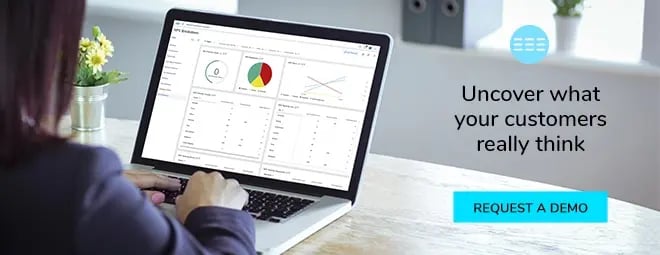As part of your Net Promoter Score (NPS) survey, we recommend including a follow-up question that measures customer retention. This question provides a good indication of the likelihood of gaining repeat business and also provides useful insights to guide your strategic business plan.

Reviewing your current data is critical
In your NPS survey, a customer retention follow-up question usually takes the form of:
“How likely are you to use our product/service again?”
In most instances, respondents can choose one of five answers:
- Highly likely
- Likely
- Undecided
- Unlikely
- Highly unlikely
To make use of this information, add up the number of responses you have in each of the five categories. The more people who are grouped under “highly likely” and “likely”, the higher your chances of having a solid returning customer base—an extremely valuable asset for any business.
At this early stage, you will learn:
- How many of your customers are likely to purchase from you again, and,
- If your current products and/or services are matching customer needs.
This may prompt you to keep to your current strategy or adjust it accordingly.
If you’re a Customer Monitor user, you can review all your retention data from your NPS surveys on the retention dashboard. Learn more here.
Multiple strategies from one metric
From your NPS survey and additional questions, you should now know:
- How many returning customers you are likely to have,
- How well your products/services are performing, and,
- Your strengths and weaknesses as a company.
From here, it’s a matter of choosing how you use this information.
Targeting the easy wins
It costs between five to 25 times more to acquire a new customer than to retain an existing one, so it pays to talk to the most satisfied customers in the loop.
A newsletter or a special email offer are good examples of this strategy. Not only will you save on acquisition costs, but repeat customers also spend 67 per cent more on average.
For example, if you sold insurance, your promoters are who you want to renew their policies as early as possible. They are the “easy wins” as they have already expressed a high likelihood of working with you again.
Tip: Read through the comments your high-retention customers give, this can give you a good idea of what your business strengths are—and how to play to them in your future business and marketing strategies.
Learn more: Dial up your NPS and your business with our free guide Grow your business with NPS
Recapture the losses
In a similar vein, you can use your NPS data to target customers who indicate that they are “unlikely” and “highly unlikely” to do business with you again. Analysing their feedback will help identify weaknesses in your business that need to be rectified.
This will help you develop a retention strategy and lower your customer churn rate, which can lead to major financial gains. According to the Harvard Business School, a 5 per cent drop in your customer churn rate can increase your profitability between 25 to 95 per cent.
Next steps
Regardless of which strategy you use (you may even use both), it is important to reach out to both your most-at-risk customers (MARCs) and your most valuable promoters (MVPs).
- MARCs tend to give a low NPS score and are highly unlikely to return.
- MVPs tend to give a high NPS score and are highly likely to return.
A simple “thank you for your feedback” can turn an MVP into a lifelong customer, further boosting your retention.
However, what’s most important is to get in touch with your MARCs.
In one survey on customer experience, 57 per cent of respondents listed “having a negative review unaddressed” as the top reason they would ‘break up’ with a brand. Reaching out to your MARCs is a chance to resolve their issues, mitigate any fallout to your business (such as negative word of mouth), and potentially even prevent the customer from churning.
While it might mean a few tricky conversations, customer experience software, such as Customer Monitor, can make the process as smooth as possible.
To see how Customer Monitor can manage your customer feedback and improve your business strategies, request a free demo today!
